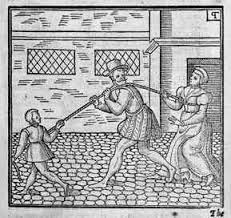
Wikimedia Commons
The Windsor witches were four women convicted at the Abingdon Assizes in Oxfordshire in 1579 of using witchcraft to cause the deaths of several prominent local citizens. They were all residents of Windsor, hence the eponym, and were executed on 26 February 1579.[1]
There are two surviving contemporary pamphlets about the case. The first, A Rehearsall both straung and true, registered in March 1579, is based on the confession given by one of the women, Elizabeth Style alias Rockingham, her surname before her marriage to John Style on 1 September 1572;[1] the other three women are named as Mother Dutton, Mother Devell and Mother Margaret. Shortly afterwards a second pamphlet was published, A brief treatyse conteyninge the most strange and horrible crueltye of Elizabeth Sule[sic] alias Rockingham[sic] and hir confederates executed at Abington upon Richard Galis. Although an apparently first-person account of being tormented by witches, it was probably at least in part written by the son of one of the alleged victims after his father’s death.[2]
Background
Richard Galis senior was a prominent local resident. He had been elected Mayor of Windsor three times, and from 1563 to 1567 was the MP for Windsor. All four of the accused women were by comparison poor and elderly, living on charity in slum dwellings.[1]
According to A Rehearsall both straung and true, shortly after some kind of disagreement with Mother Dutton, Galis and his fifteen-year-old brother James fell ill, and James subsequently went mad. So convinced was Galis that Mother Dutton had bewitched him and his brother that in 1572, after his recovery, he dragged her to a prison in Windsor and demanded that she be incarcerated until she had been seen by magistrates. But the jailer refused, having received no instructions to receive the prisoner, and Mother Dutton was released.[1]
Six years later, in1578, three female wax images with bristles stuck in their hearts were discovered in London, believed to represent Queen Elizabeth I and two of her privy councillors. Similar images having been found in the possession of the Windsor witches, Sir Henry Neville, a local Justice of the Peace and the Dean of Windsor, was tasked by the Privy Council to investigate whether the women were plotting to secure the Queen’s death by the use of magic.[1]
Confession, trial and execution

Berkshire Local History Association
Richard Galis senior personally delivered the four women – Elizabeth Style, Mother Devell, Mother Dutton and Mother Margaret – to Windsor Castle, where they were questioned about their religious beliefs and ordered to attend the parish church the following day to “publikly in presence of all men be set under the pulpit during the time of the service.” They were then sent to Reading to await trial.[1]
Each of the women was accused of keeping a familiar, a sure sign of witchcraft in Elizabethan England: Mother Dutton a toad, which she fed with her blood; Mother Devell a black catThe numerous folk beliefs about black cats, and cats in general, are often contradictory. Superstitions surrounding black cats are almost certainly some of the most prevalent even today, along with the number thirteen and walking under a ladder. called Jill, Mother Margaret a kitten named Jenny, and Elizabeth Style a rat called Philip. Once incarcerated, Elizabeth, a 65-year-old widow, confessed to the crimes she claimed to have committed against local citizens by the use of witchcraft, including the murders of two butchers and the tormenting of Richard Galis. The other women made no confessions, but all four were convicted on the basis of Elizabeth’s statement and sentenced to death by hanging, which they were on 28 February 1579.[1]
Modern interpretation
The historian Marion Gibson has described the Brief treatyse pamphlet as “highly unusual”, being apparently a first-person account written by the victim of a witch-attack. She goes on to describe it as a “reasonably unified … narrative by a single author”.[3] But Richard Galis senior died in 1574,[1] and the pamphlet was not published until 1579 in response to A Rehearsall both straung and true published earlier that same year, which incorporates text from that earlier pamphlet.[3] The most likely scenario is that Richard Galis senior began the work, and his son continued it after his father’s death in an effort to expose the culpability of the local authorities in 1572, when they had refused to bring the four women to trial despite the urging of his father.[1]
